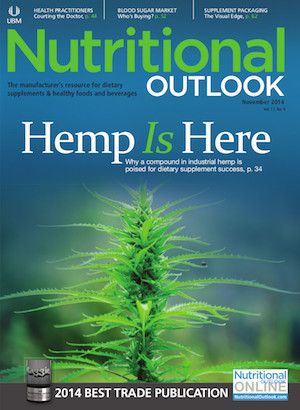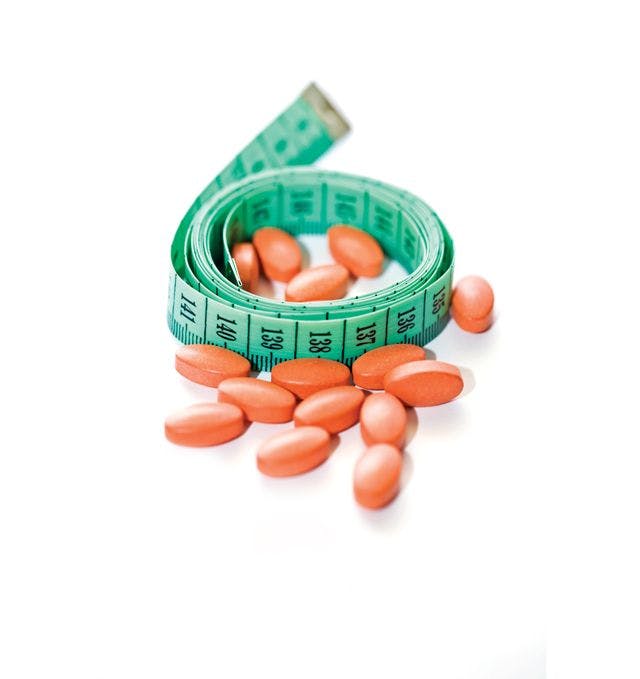Who Is the Blood Sugar-Management Dietary Supplement Customer?
A lot of us, it turns out

November is National Diabetes Month in the United States, and the latest statistics out of the Centers for Disease Control and Prevention are alarming, to say the least. At least 9.3% of the U.S. population has diabetes (diagnosed and undiagnosed), according to the CDC’s 2014 National Diabetes Statistics Report.1 Diabetes cases cost $245 billion in annual direct and indirect medical expenses in the United States in 2012, and there were 1.7 million new diabetes cases in 2012 alone. Although diabetes is a rampant global disease, one fact to remember is that, at least for some, preventive steps can be taken.
Prevention is especially relevant to those with prediabetes-people with high blood sugar levels that haven’t yet scaled up to the condition of diabetes. The CDC estimates that 37% of U.S. adults suffer from prediabetes.
For these individuals, there may still be time to take back the reins of blood sugar management and try to steer levels back to a healthy range through weight loss and increased physical activity. Proactive individuals can also consider adding dietary supplements and healthier foods and beverages to the mix to help manage blood sugar and, combined with lifestyle changes, hopefully sidestep a slide into diabetes and its associated adverse conditions, including heart disease, stroke, and blindness.
Approaching Blood Sugar Effectively
To recap, a body maintains healthy blood sugar levels thanks to the hormone insulin. Insulin helps transport glucose from the blood-keeping blood sugar levels in a healthy neighborhood-to muscle, fat, and liver cells where glucose is used for energy, among other critical functions. A diet high in quickly digested carbohydrates-the refined sugars and starches that break down easily into glucose and yet comprise a large portion of today’s Western diet-causes blood sugar levels to quickly spike post-meal, otherwise known as a high-glycemic response. Under healthy conditions, the body’s pancreas would produce and release more insulin to the blood to deal with glucose spikes; however, those with diabetes and prediabetes have insulin insensitivity, and the body’s insulin response cannot effectively handle the glucose challenge. As a result, blood sugar levels remain in a prolonged state of hyperglycemia, potentially leading to a range of adverse health effects. Most (90%-95%) of people with diabetes have type 2 diabetes, a state that can be spurred by excess weight, a lack of physical exercise, and a diet too rich in refined, quickly digested carbohydrates that keep the body in this hyperglycemic state.
Dietary supplements and healthier foods and beverages attempt to help bring blood sugar levels back in the balance, and they can do so in many different ways. Slowly digested, low-glycemic starches and sugars-as opposed to blood sugar–spiking, high-glycemic starches and sugars-can help avoid rapid glucose spikes. Still other approaches include no-sugar and low-sugar formulations, ingredients to control sweets cravings, and ingredients to influence carbohydrate metabolism. Product marketers should remember, however, that there are many types of potential customers for blood sugar products, and connecting successfully with the target customer depends on the right approach.
Food and Beverage
“Many consumers do not want to buy foods and beverages that are positioned to a disease state,” says Pam Stauffer, global marketing programs manager for Cargill (Minneapolis). As such, a lot of food and beverage marketers these days avoid a “direct” diabetes angle. While some do mention diabetes directly when describing their products-see Abbott’s Glucerna nutrition bar line and the Diabalance food line in Spain-still many more tend to focus on generally healthy attributes. Indeed, these types of claims may appeal to a group (especially those with prediabetes) that doesn’t necessarily consider itself “diseased” but that is encouraged by practitioners to improve health and wellness in general through healthier diet and lifestyle choices.
“Currently, the leading label claim for blood sugar–targeting products is indeed the low/no/reduced-sugar health claim,” says Joseph O’Neill, president and general manager for Beneo Inc. (Morris Plains, NJ). “The reason behind this is that sugar reduction is relevant for everyone.”
“The most important thing to realize is that [people with diabetes and prediabetes] are not different from others in their general attitudes towards nutrition,” adds Barbara Katz, president of HealthFocus International (St. Petersburg, FL), a market research firm specializing in health and nutrition. This past April, the company released a report, “The Consumer Side of Diabetes,” with insights on how people with diabetes and prediabetes view nutrition and which product attributes they seek, based on survey results from 1200 U.S. consumers.
“In our study, over half of people with diabetes fell into a group that we call ‘Middle of the Road,’ defined as people who are aware that diet is important to health but for the most part who eat what they want. Sometimes that will be a salad, and sometimes it will be a pizza with extra cheese. But it all evens out to be not too bad,” Katz says. Only 11% of people with diabetes fall into a group that HealthFocus terms “Health Managers,” those that manage their eating habits to focus specifically on addressing an illness.
Belgian ingredients supplier Cosucra categorizes blood sugar–product consumers in three groups. (The company supplies the blood sugar market with its non-digestible, low-glycemic chicory fiber Fibruline, which not only offers a source of soluble dietary fiber but also lends sweetness without impacting blood glucose levels. Cargill sells Fibruline on behalf of Cosucra in the United States under the name Oliggo-Fiber.)
First, Cosucra says, there are people with diabetes and prediabetes. These people “are ready to buy premium products with proven benefits” and “understand messages of glycemic index/glycemic load and blood sugar management.”
Then there are “lifestyle consumers,” who don’t necessarily want “diabetes” products but who are seeking overall good health. These “lifestyle consumers” respond to specific messages of “maintains healthy blood sugar levels,” “reduced sugar,” “X% less sugar,” and other scientific messages, as long as those messages are understandable.
And, finally, there’s the mass-market customer, who won’t pay a higher price for a product; more likely this customer is looking to lose weight and is thus drawn to more-general claims of “low sugar,” “reduced sugar,” or “no added sugar.”
“At Cosucra, we think that claims related to blood sugar levels, such as the one the European Food Safety Authority (EFSA) recently accepted for chicory-derived inulin, could appeal to [those with diabetes and prediabetes] but also ‘lifestyle’ consumers,” says Sabrina Marnet, product manager, chicory ingredients.
Following petitioning from chicory inulin suppliers Beneo, Sensus, and Cosucra, EFSA issued a positive opinion this past January linking non-digestible carbohydrates, in place of sugars, with a lower postprandial blood glucose rise. Cosucra suggests marketers use consumer-friendly wording such as “When replacing a minimum of 30% of sugars by Fibruline chicory inulin in foods/drinks, you induce a lower blood glucose rise after their consumption compared to sugar-containing foods/drinks,” paired with visual aids for further explanation.
Also, remember that people with diabetes and prediabetes still want to enjoy their food just like anyone else. For instance, “lifestyle” consumers in particular may be more attracted to moderate (30% or less) versus drastic sugar reduction, according to Cosucra. These customers, Cosucra says, are looking for more “balance.”
When polled on what they look to avoid in foods, HealthFocus survey respondents noted these as the top five: sugar, carbohydrates, added sugar, sodium, and saturated fat-basically, attributes that any health-minded food shopper might seek. On the flip side, the survey respondents indicated that they do seek good sources of protein, fiber, and whole grains-again, desirable features to many a shopper.
“If there is a difference amongst people with diabetes, it is that they are even more taste-focused than other groups and more concerned that healthy foods won’t taste good,” HealthFocus’s Katz says. “So, with that background, the best way to communicate with them is with the assurance that they aren’t going to be making a taste sacrifice with your product.”
Thankfully, today’s formulators have a robust toolbox with which to make delicious foods and beverages friendlier to blood sugar status, thanks to innovative ingredient suppliers. Low-glycemic options can substitute high-glycemic starches and sugars, oftentimes without sacrificing taste or texture. (From a formulator’s point of view, sugar provides essential, functional bulking properties that are not always easily replaced.)
Ingredion’s (Westchester, IL) Hi-maize resistant starch (60% insoluble fiber; 40% digestible starch content), which resists digestion, acts like a dietary fiber in the digestive tract. The company describes it as “a white cornstarch that easily replaces part of the flour in your favorite everyday foods without changing their taste, texture, or appearance.” Extensive research shows that Hi-maize minimizes blood sugar spikes compared to typical carbohydrates, aids insulin function, and can even lower the glycemic impact of future meals eaten hours later.
Ingredient supplier Beneo offers numerous options to lower the glycemic effect of foods and beverages. With the ability to replace high-glycemic sugars, the company’s chicory-derived, non-digestible prebiotic inulin and oligofructose fibers act as low-intensity sweeteners and a source of fiber and satiety, all without impacting taste. “Used in combination with high-intensity sweeteners, they even help to mask undesired off-notes,” O’Neill says.
Beneo also supplies isomalt, which O’Neill describes as “the only sugar replacer derived from sugar beet” that can substitute sucrose 1:1, while maintaining texture. Isomalt is not fully digested, lessening its effect on blood sugar, and can also be applied to direct-compression dietary supplement tablets and sugar-free mints.
In addition to sugar replacers, Beneo provides Palatinose, a low-glycemic, slow-release sugar that, compared with high-glycemic sugars, provides the body with a sustained source of energy over a longer period of time. “The carbohydrate energy enters the body in a slow, low, and sustained way,” O’Neill says.
In addition to supplying the tasteless, odorless, and texture-neutral Oliggo-Fiber chicory inulin, Cargill’s Xtend sucromalt is a slowly and fully digestible sweetener syrup that impacts neither glycemic index nor product texture, the company says. Cargill also offers Isomaltidex isomalt for glycemic-friendly formulation.
Dietary Supplements
Whereas even the casual food shopper will likely stumble upon a reduced-sugar food in his or her lifetime, dietary supplement consumers tend to know what they are looking for from the start: blood sugar support. HealthFocus International survey data indicate that nearly a quarter of people with diabetes say they always/usually take supplements targeting blood sugar management.
“In supplements, consumers are seeking direct ‘support,’” says Mitch Skop, senior director of new product development for Pharmachem Laboratories Inc. (Kearny, NJ).
“The supplement market is definitely more direct in its approach to the blood sugar market,” agrees Max Motyka, MS, RPh, director of sales and marketing for Albion, Human Nutrition Division (St. Clair Shores, MI). “This is…obvious looking at the way the supplement market names and describes its blood sugar products.” Indeed, the supplements shelf is rich with “blood glucose support” formulations.
Most blood sugar–supplement shoppers are also familiar with claims of supporting healthy blood sugar. “Due to FDA/FTC regulations, which consumers are now used to since 1994, the claim ‘supporting healthy blood sugar’ is well understood,” Skop says. Even for mainstream customers new to the supplements aisle, “we still believe that such a claim is not ambiguous; conversely, it’s rather crystal clear. It is also truthful and non-misleading,” he adds.
More supplement shoppers are learning about the way in which different blood sugar ingredients work. For instance, an ingredient that inhibits carbohydrate breakdown and glucose absorption by the blood, such as Pharmachem’s Phase 2 Carb Controller white kidney bean extract, is “predominantly” understood, according to Skop. While many shoppers seek Phase 2 for weight-management purposes, they may be interested to know that a 2009-published study in The Open Nutraceuticals Journal suggests that the ingredient also helps to inhibit hyperglycemia.2 More recently, in a study published in 2011 in Nutrition Journal,3 researchers further determined that Phase 2 may help reduce postprandial blood sugar spikes.
“Products that act on glucose can do so in a number of ways, but for simplification I like to classify them into two categories,” says Jocelyn Bérubé, MSc, scientific director, health and nutrition, InnoVactiv (Rimouski, QC, Canada). “There are products that act on sugar before it gets into your body, and others that act on how your body uses glucose once it is in the body. It really follows what happens after a meal. Glucose gets in the blood (from digestion), and then your metabolism gets glucose out of the blood (to make energy, or fat, or something else). If you want to act on the in phase, you can, for example, slow down the digestive enzymes that cut large starch and sugar molecules into single glucose. You could also inhibit the transport of that glucose across the intestinal wall.”
However, he continues, “If you want to act on the out phase, you could facilitate insulin release or secretion, improve the sensitivity of cells to insulin, increase conversion of sugar to either glycogen or fat, and many other things. This will all have the effect of lowering blood glucose more rapidly.” But, according to Bérubé, growing consensus in the scientific community is that increasing insulin production through artificial means may not be the best route because the body could potentially end up becoming moredesensitized to insulin. “The best strategy, and the one with the most beneficial impact on health, is really to work upstream by reducing the entry of glucose into the body,” he says.
This April, InnoVactiv’s InSea2 ingredient launched in a new carbohydrate-inhibiting supplement, Cebolixs, by Euro-Pharm International. InSea2 contains phlorotannin polyphenols, derived from the brown seaweed species Ascophyllum nodosum (kelp) and Fucus vesiculosus (bladder wrack). InSea2 helps to inhibit the enzymes that spur carbohydrate breakdown: alpha-amylase and alpha-glucosidase. By inhibiting these enzymes, human studies show InSea2 can help to modulate both starch and sugar digestion, and the result is lowering blood glucose levels (by up to 48.3%), while also lowering blood insulin levels and increasing insulin sensitivity, right after first use of the product.
Pharmachem also supplies Prenulin, a proprietary combination of Chromax chromium picolinate and a unique form of L-arabinose. A 2011 Nutrition Journal study demonstrated that Prenulin consistently and significantly lowered circulating glucose and insulin after a 70-g sucrose challenge, without adverse effects.4 “It operates in two separate modes,” Skop explains. “L-arabinose, derived from the corn plant, acts as a sucrose ‘blocker,’ which reduces the digestion of sugar. Chromium picolinate (Chromax) helps metabolize the sugar that is ingested in a more healthful way.”
Bill Levi, vice president of strategy and business development at Nutrition 21 LLC (Purchase, NY), the manufacturer of Chromax, points to more than 51 human clinical studies and FDA qualified health claims confirming Chromax chromium picolinate’s effectiveness in helping to maintain healthy glucose metabolism. This includes clinical studies showing superior absorption compared to other chromium forms. Nutrition 21 is now highlighting further dimensions of diabetes impact, including a link between high glucose levels and risk of dementia, recently highlighted in the New England Journal of Medicine.5 “Chromax chromium picolinate supports brain glucose transporter function and contributes to healthy glucose metabolism, significantly affecting a healthy mood and cognitive function,” said James Komorowski, Nutrition 21’s vice president of scientific and regulatory affairs, in a press release.
Chromium, as well as supplement ingredients like Gymnema sylvestre and cinnamon, are commonly understood, Albion’s Motyka says. But increasing research is also paving the way to a larger market presence for magnesium, zinc (especially for those with type 1 diabetes), and alpha-lipoic acid, he says. Albion supplies the following minerals for type 2 diabetes and prediabetes, in the form of bioavailable bisglycinate chelates: magnesium (including a buffered form), zinc (both bisglycinate and arginate chelates), and chromium nicotinate glycinate.
Magnesium, which is a key cofactor for enzymes involved in carbohydrate metabolism, as well as a key factor in insulin sensitivity, “is of prime importance,” Motyka says. Deficiency has been linked to both insulin resistance in obese children and increased risk of type 2 diabetes in adults. Unfortunately, of all minerals, the U.S. population is most deficient in magnesium. And zinc, he adds, plays a key role in fighting insulin sensitivity by helping to prevent the malfunction of the protein amylin, which otherwise results in “shutting down” insulin-producing cells. Those with diabetes, however, tend to have more trouble absorbing and utilizing zinc.
Research is in the early stage for a grape seed extract ingredient Polyphenolics (Madera, CA) introduced this year for healthy blood sugar maintenance. Announced in April, MegaNatural-GL differs from the company’s flagship grape seed extract ingredient, MegaNatural-BP, which aids in healthy blood pressure. Although both ingredients are founded on grape seed extract, “MegaNatural-BP…has a molecular structure which enters the bloodstream quickly. MegaNatural-GL, on the other hand, maintains its characteristics in the digestive tract, where it can have the greatest benefit,” explained president Anil Shrikhande, PhD, in a press release. Pilot studies at the University of California, Davis, conducted in healthy subjects and subjects with metabolic syndrome suggest MegaNatural-GL may help increase insulin sensitivity and glucose metabolism, especially after dinner, a time of day during which the body’s ability to manage glucose may be lowest, compared to the morning.
Consumer Education
The high prevalence of diabetes and prediabetes opens the door to possible assistance from dietary supplements, foods, and beverages. But, as InnoVactiv’s Bérubé points out, there is still a great deal of education needed to help consumers understand diabetes in general, as well as its triggers and the role that nutrition can play. HealthFocus International seconds this, stating, “There appears to be a high lack of awareness among people at risk in regards to their overall health and diabetes risk.” Cosucra’s Marnet adds, “Indeed, products specifically targeting diabetes are not spreading in the mainstream market, as mass-market people do not understand the ‘scientific’ messages present on those products”-which makes targeted marketing all the more relevant.
“One important aspect that people have to understand is that we spend most of our waking hours in a postprandial (post-meal) situation,” Bérubé adds. Once we’re done eating, it usually takes around two hours for postprandial glucose levels to return to fasting levels (such as when you first wake up). But if insulin resistance is present and insulin signaling is not optimized, bringing those blood sugar levels down can take a lot longer. So, instead of being in a postprandial glucose state for, say, six hours of the day following each daily meal, we may spend as many as nine or more hours awake in a post-meal, elevated-glucose state. And that doesn’t even count spikes that occur after snacking.
Sadly, Bérubé says, people may not even notice the fluctuations between glucose highs and lows, meaning that many don’t even realize the rigors we put our bodies through simply by indulging in high-glycemic foods throughout the day. (People with diabetes, by contrast, often experience symptoms such as dizziness when their blood sugar levels are too low, so they may be more aware of when levels change.) Likewise, we don’t realize the damage that we’re doing. Of hyperglycemia, Bérubé says. “It is like ‘rusting’ the body by adding glucose molecules on many different proteins like hemoglobin, collagen, enzymes, and others, which then lose part or their entire functions.”
Don VerHulst, MD, chief science officer for InBalance Health Corp., believes more focus is also needed not just on the symptoms of high blood sugar but on the cause-in his words, “toxic belly fat.”
“The enemy is what I call toxic belly fat,” VerHulst says. “Excess abdominal fat is what causes insulin resistance, which leads to dangerous, higher blood sugar. Although traditional medicine, which I am trained in, has become very good at keeping blood sugar levels within an acceptable range, it often ignores the cause of the problem. You see, high blood sugar is a symptom, not the cause, of the problem.” He says InBalance’s InBar nutrition bars and dietary supplements, alone or in conjunction, can help consumers manage their weight and glucose levels and provide “a simple solution to what can seem like a complicated health issue.”
Pharmaceutical firm Boston Therapeutics, together with marketing firm Benchworks, is working on a blood sugar awareness campaign for its new carbohydrate-blocking dietary supplement, Sugardown, whose ingredients include galactomannan. The plan will include an active social media and public relations reach-out, as well as a partnership with PreDiabetes Centers around the United States, to grow awareness around Sugardown and the importance of maintaining healthy blood sugar levels throughout the day.
“We believe that there is more need to explain the role that a dietary supplement plays in helping patients manage their health,” says David Platt, PhD, CEO of Boston Therapeutics. “We believe that consumers need to understand how Sugardown works. That is why we are providing as much education as possible.”
Opportunities to Help
Although more education is needed to drive the blood sugar market, there’s one, certain market driver that doesn’t appear to be going away anytime soon: the high number of people trending towards diabetes who need to take preventive steps. As Nutrition 21’s Levi puts it, currently “the sale of blood sugar supplements does not match the size of the population of people who are insulin resistant.”
InnoVactiv’s Bérubé says that while the blood sugar category can be challenging, the number of blood sugar products will continue to grow as consumers get the message to cut sugar and high-glycemic food intake.
“Products with unjustifiably high amounts of sugar keep receiving a lot of criticism, and the sugar level of food and beverages is about to become much more important,” Beneo’s O’Neill says. “Consumers know that they need to focus on their health, but they often struggle with changing their habits or following one diet after another.” Dietary supplements and foods and beverages that allow customers to eat more healthily without sacrificing enjoyment are tools we can all consider. After all, Bérubé says, “Blood glucose maintenance is a building block that should be part of any health-maintenance strategy.”
Also read:
Blood Sugar Dietary Supplement, Food Products in the Mainstream Market
References
- National Diabetes Statistics Report, 2014. Centers for Disease Control and Prevention. www.cdc.gov/diabetes/pubs/statsreport14/national-diabetes-report-web.pdf
- Vinson J et al., “Investigation of an amylase inhibitor on human glucose absorption after starch consumption,” The Open Nutraceuticals Journal, vol. 2 (2009): 88-91
- Barrett ML et al., “A proprietary alpha-amylase inhibitor from white bean (Phaseolus vulgaris): a review of clinical studies on weight loss and glycemic control,” Nutrition Journal, Published online March 17, 2011
- Kaats GR et al., “A combination of L-arabinose and chromium lowers circulating glucose and insulin levels after an acute oral sucrose challenge,” Nutrition Journal. Published online May 6, 2011
- Crane P et al., “Glucose levels and risk of dementia,” New England Journal of Medicine, vol. 369, no. 6 (August 8, 2013): 540-548
Photo © iStockphoto.com/Hlib Shabashnyi

HHS announces restructuring plans to consolidate divisions and downsize workforce
Published: March 27th 2025 | Updated: March 27th 2025According to the announcement, the restructuring will save taxpayers $1.8 billion per year by reducing the workforce by 10,000 full-time employees and consolidating the department’s 28 divisions into 15 new divisions.
















